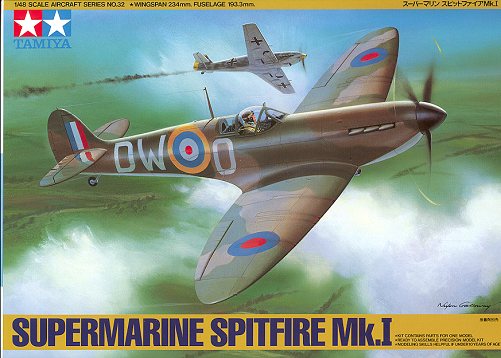
Tamiya 1/48 Spitfire I
|
KIT: |
Tamiya 1/48 Spitfire I |
|
KIT # |
61032 |
|
PRICE: |
$26.95 |
|
DECALS: |
Two Aircraft: See review |
|
REVIEW & |
|
|
NOTES: |

|
HISTORY |
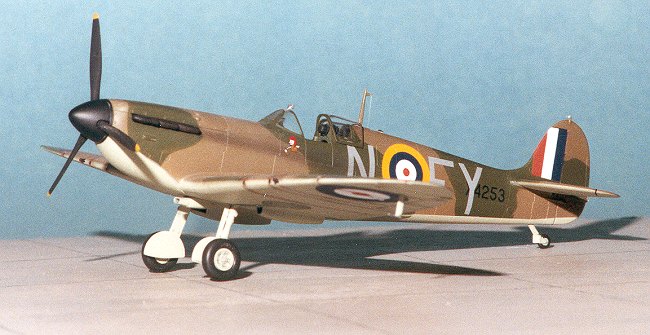
One of the few aircraft to remain in production from the beginning of the war to the end, the Supermarine Spitfire gained popular acclaim during the Battle of Britain as its pilots bravely fought against the Luftwaffe during the Summer of 1940. Ignoring the fact that the Hurricane was the more numerous of the two and that it did most of the bomber interception, the Spitfire is the one that strikes our fancy of 'the few' who fought during those perilous time.
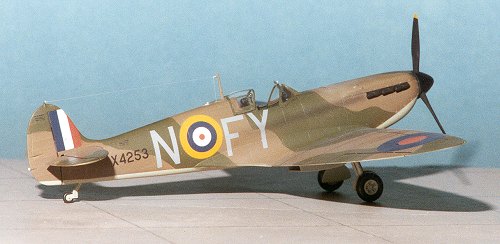 Designed about the same time as it's adversary, the Bf-109, the Spitfire was a
much more elegant aircraft; full of curves where the 109 was all angles. This
curvaceous design also meant that it was more difficult to construct and repair,
but gave it excellent maneuverability compared to the faster 109E.
Designed about the same time as it's adversary, the Bf-109, the Spitfire was a
much more elegant aircraft; full of curves where the 109 was all angles. This
curvaceous design also meant that it was more difficult to construct and repair,
but gave it excellent maneuverability compared to the faster 109E.
Like the 109, the Spitfire was designed as a point defense fighter and not a longer range bomber escort. The Spitfire I and II was never fitted with the bulky long range drop tanks as eventually was the 109E since most combat between the two occurred over British territory and bases. Subsequent Spitfire designs changed that and the Spitfires of 1945, while still obviously a Spitfire, had no parts in common with the 1939 versions.
|
THE KIT |
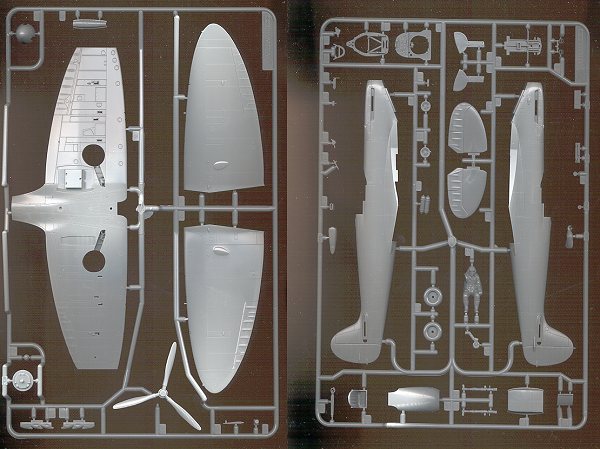
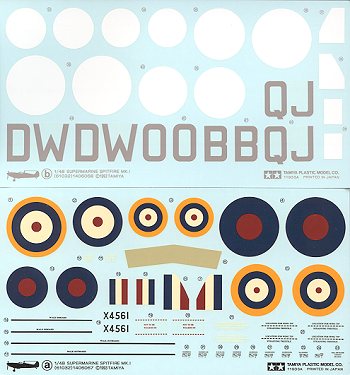 Back in the early 1990's,
Tamiya decided to re-enter the 1/48 aircraft market. They did this by
concentrating on WW2 single-engine fighters, and one of those kits was the
Spitfire I. Needless to say, the buying public showed their support and
gratitude by snapping them up as they came out. It was about time that a modern
mold of this aircraft was produced and it was well worth the wait.
Back in the early 1990's,
Tamiya decided to re-enter the 1/48 aircraft market. They did this by
concentrating on WW2 single-engine fighters, and one of those kits was the
Spitfire I. Needless to say, the buying public showed their support and
gratitude by snapping them up as they came out. It was about time that a modern
mold of this aircraft was produced and it was well worth the wait.
Consisting of about 50 parts on three sprues (one clear and not shown), the Tamiya Spitfire appears to be a very simple aircraft to build. With no add on parts like rockets, bombs, or drop tanks, it is the essence of pure fighter. Add to that the interesting color schemes of the early war RAF and you have a very desirable kit. The only real option is for an open or closed canopy as the spit didn't have any leading edge slats and Tamiya chose not to make lowered flaps an option. Frankly, the Spit only lowered them upon landing and they were immediately retracted to prevent damage during taxiing.
Decal options are for two aircraft: First is DW*O from 610 Squadron in standard colors of Dark Green and Earth uppers with a Sky lower surface. The other is QJ*B of 92 Squadron, in similar colors to DW*O, but with the left wing underside in black. The size of the wing and fuselage roundels is different between the two. Tamiya thoughtfully supplies white circles to underlay the roundels so there is no color bleedthrough from the underside camouflage. Also included is a full page camouflage marking scheme for those that want to use it for a pattern, as the camo schemes of the day were done by using large rubber masking mats.
|
CONSTRUCTION |
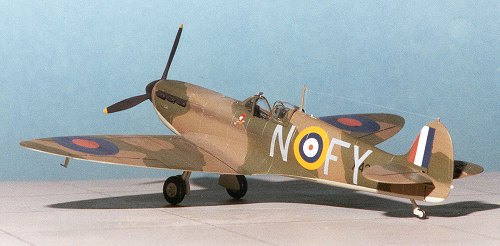 Just looking at this
kit, I knew it would be a very nice, relaxing build with minimal hassles. It has
been a while since I did a Tamiya aircraft kit and was looking forward to it.
First step was to start to assemble the interior. All those pieces to be painted
the same color were glued together and the interior was painted a nice Interior
Green that I had premixed from various greens. When dry, the various bits and
pieces were painted as per the instructions, then washed with dirty thinner and
finally drybrushed with Aluminum Metallizer. Unlike their later kits, there is
no instrument panel decal, which is a shame as they are very nice.
Just looking at this
kit, I knew it would be a very nice, relaxing build with minimal hassles. It has
been a while since I did a Tamiya aircraft kit and was looking forward to it.
First step was to start to assemble the interior. All those pieces to be painted
the same color were glued together and the interior was painted a nice Interior
Green that I had premixed from various greens. When dry, the various bits and
pieces were painted as per the instructions, then washed with dirty thinner and
finally drybrushed with Aluminum Metallizer. Unlike their later kits, there is
no instrument panel decal, which is a shame as they are very nice.
While the interior was drying, the fuselage halves were cemented together as were the wings. Again, no hassles and a very good fit. The underside nose piece was glued in place at this time. The interior gets installed from underneath in this kit so once the fuselage and wings were cleaned up, the interior was installed. Now make sure that you don't put the interior in too far or you won't get the canopy bits to fit. It might not be a bad ideal to test fit the aft canopy piece at this time to ensure it isn't sitting too high. It is easy to do and saves a lot of anxiety later (I know, as mine was in too high!).
 The wings are then installed
and the fit is really great. I goofed a bit and needed some filler at the aft
wing join, but other than that it was a perfect fit. Like other Tamiya kits, the
radiators are installed from the outside. The various grills were painted black
and drybrushed to bring out detail. Then all the various radiator covers were
glued in place. The horizontal stabilizers were then glued in place. While the
airframe was drying, the canopy sections were masked with Bare Metal Foil. You
are given three center canopy sections to use. Apparently the flatter of the
three is for this kit, but frankly, you can used one of the more bulged ones and
be equally correct. At least only a Spitfire expert will know the difference!
The gunsight was then glued in place and then the canopy bits glued in place
using non-fogging superglue. The sliding section was tack glued with Elmer's
white glue and it was off to the paint shop.
The wings are then installed
and the fit is really great. I goofed a bit and needed some filler at the aft
wing join, but other than that it was a perfect fit. Like other Tamiya kits, the
radiators are installed from the outside. The various grills were painted black
and drybrushed to bring out detail. Then all the various radiator covers were
glued in place. The horizontal stabilizers were then glued in place. While the
airframe was drying, the canopy sections were masked with Bare Metal Foil. You
are given three center canopy sections to use. Apparently the flatter of the
three is for this kit, but frankly, you can used one of the more bulged ones and
be equally correct. At least only a Spitfire expert will know the difference!
The gunsight was then glued in place and then the canopy bits glued in place
using non-fogging superglue. The sliding section was tack glued with Elmer's
white glue and it was off to the paint shop.
|
PAINT & DECALS |
Early Spits were painted in Earth and Dark Green uppers with either Sky, light blue, or black & white undersides. This aircraft is pretty normal having a sky underside. Frankly, I find the browns and greens to be much more appealing than the later gray/green scheme. Another bonus is no leading edges to paint yellow and no fuselage band to mess with!
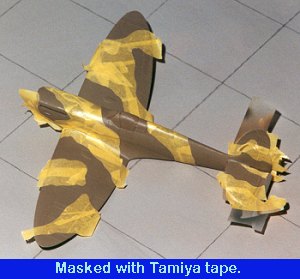 All the camouflage colors are Aeromaster with the upper colors
being enamels and the underside being acrylic. The underside was painted Sky as
was the gear doors, struts and wheelwells. At this time, the cockpit area
was painted interior green. When dry, the tailplane undersides were masked and
the upper surface was painted Earth. The next day, the upper surface
camouflage scheme was masked using Tamiya masking tape. I have just started
using it and find it to be superb stuff! The Dark Green was then sprayed
on and when dry, the masking was removed. Now the upper surface was done
and so masked off and the some of the underside was spray painted again to take
care of any overspray.
All the camouflage colors are Aeromaster with the upper colors
being enamels and the underside being acrylic. The underside was painted Sky as
was the gear doors, struts and wheelwells. At this time, the cockpit area
was painted interior green. When dry, the tailplane undersides were masked and
the upper surface was painted Earth. The next day, the upper surface
camouflage scheme was masked using Tamiya masking tape. I have just started
using it and find it to be superb stuff! The Dark Green was then sprayed
on and when dry, the masking was removed. Now the upper surface was done
and so masked off and the some of the underside was spray painted again to take
care of any overspray.
Now that the major part of the painting was done, it was time for the decals. But before this was done, the main landing gear and tail wheel were glued in place to allow the kit to have something to stand on while the decals dried. I decided against the kit markings because they were a bit thick, the white was a sort of ivory color, but mostly because I has spent $20 on a very nice Aeromaster Special on the Battle of Britain.
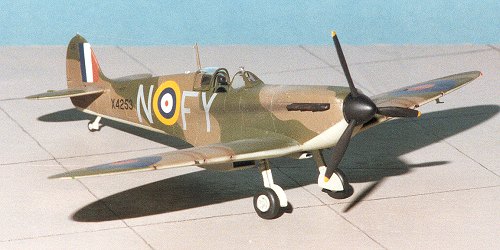 The aircraft I had decided upon was X4253 from 611 Squadron.
This aircraft was flown by Pilot Officer W. Duncan Smith, who eventually reached
a score of 40 victories before the war was over. This aircraft also had
underwing roundels and a small personal marking just under the windscreen.
The aircraft I had decided upon was X4253 from 611 Squadron.
This aircraft was flown by Pilot Officer W. Duncan Smith, who eventually reached
a score of 40 victories before the war was over. This aircraft also had
underwing roundels and a small personal marking just under the windscreen.
I used the kit decals for all the small maintenance markings. Naturally, I discovered a small sheet of these same markings in the much thinner Aeromaster decals after I had applied the last one and opened the bag to get out the specific markings! DOH! The Aeromaster and Tamiya decals went down well. The Aeromaster decals were assisted with Superscale setting solution, while the Tamiya ones were treated to the much stronger Champ solution.
|
CONSTRUCTION CONTINUES |
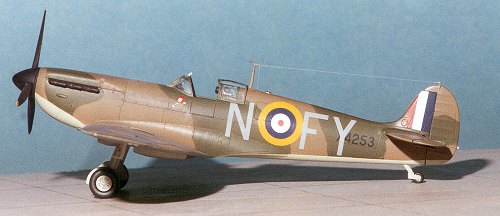 After the decals had fully dried, the kit was wiped down with
clear water to remove any excess setting solution. Then the rest of the small
bits and pieces were added such as the wheels, gear doors, radio antenna, prop,
spinner and pitot tube. I did have a glitch at the very end when the pitot tube
fell over into its small drop of glue, causing the glue to eat the paint and
decal under it. Why can I not do a kit without something happening to it?!
After the decals had fully dried, the kit was wiped down with
clear water to remove any excess setting solution. Then the rest of the small
bits and pieces were added such as the wheels, gear doors, radio antenna, prop,
spinner and pitot tube. I did have a glitch at the very end when the pitot tube
fell over into its small drop of glue, causing the glue to eat the paint and
decal under it. Why can I not do a kit without something happening to it?!
After final paint touchup, the kit was sprayed with clear semi-matte. Then pastels were used for engine and gun exhaust stains. These were lightly applied. Much weathering that I see like this is overdone and it is a real trick not to overdo it. The weathering was then sealed with more clear matte, and the masking taken off the canopy bits. Final steps were the addition of the rear view mirror and the radio long wire, which was represented with stretched sprue and is nearly invisible, just like on the real thing!
|
CONCLUSIONS |
I really cannot say enough about how much I enjoyed building this kit. Sure, it is a modern 'shake and bake' kit, but that takes nothing away from the pleasure of constructing a well-engineered model. I can heartily recommend this kit to all levels of modeler. You will all enjoy it as much as I did.
May 2000
Review copy courtesy of me and my wallet!
If you would like your product reviewed fairly and quickly, please contact me or see other details in the Note to Contributors.